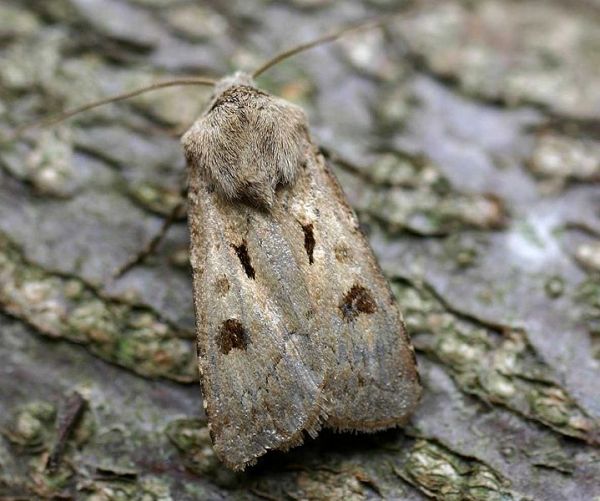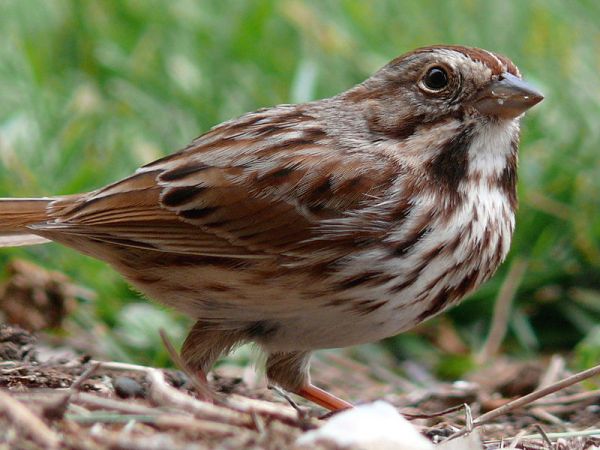This issue of Science Shots is taken entirely from today’s Proceedings of the Royal Society B (early view)—an unusually lively collection of forthcoming papers.
First up, a fascinating look at the long-distance migration strategies of birds and moths—specifically of songbirds (generally, the small twitterers) and noctuid, or owlet, moths (generally, the heavy-bodied moths that fly into lights at night).
The moths, as might be expected, attain self-propelled flight speeds only a third as fast as the flight speeds of songbirds. Yet the radar data used for this study show that during high-altitude migration, the moths fly as fast as the songbirds. So how do they do it?
Moths achieved fast travel speeds in seasonally appropriate migration directions by exploiting favourably directed winds and selecting flight altitudes that coincided with the fastest air streams. By contrast, [songbirds] were less selective of wind conditions, relying on self-powered flight in their seasonally preferred direction, often with little or no tailwind assistance.
 Heart and dart moth, Agrotis exclamationis. Credit: ©Entomart.ins, via Wikimedia Commons.
Heart and dart moth, Agrotis exclamationis. Credit: ©Entomart.ins, via Wikimedia Commons.
For a long time now we’ve known that most birds that practice monogamy also cheat on their partners—what biologists call social monogamy (versus sexual monogamy). The basic hypothesis has been that cheating offers genetic benefits to the female by, for instance, mixing up her DNA with a male with different traits and potential talents.
The study used 18 years of data from wild song sparrows to examine the survival rates of the chicks born out of bird-wedlock compared to the chicks born within bird-wedlock. Lo and behold, not what anyone expected.
On average, there was no difference between chicks born in and out of wedlock (measured for hatching, fledging, recruitment, and total lifespan). However, chicks born out of wedlock consistently tended to be less likely to survive. Here’s where it gets interesting: the difference was sex specific:
- Female chicks born out of wedlock were less likely to survive to independence and recruitment than female chicks born within wedlock
- Female chicks born out of wedlock lived fewer years than female chicks born within wedlock
- Male chicks born out of wedlock were similarly or slightly more likely to survive and to live more years than male chicks born within wedlock
The findings tend to raise more questions than they answer, paradoxically a mark of scientific progress.
 Song sparrow, Melospiza melodia. Credit: Ken Thomas, via Wikimedia Commons.
Song sparrow, Melospiza melodia. Credit: Ken Thomas, via Wikimedia Commons.
Finally, in another paper, researchers attempted to discern the level of empathy domestic hens feel for their chicks. The premise here being that empathy—the extent to which an animal is affected by the pain or distress of one of its own kind—likely evolved first among parents for their young and later spread to others, at least in some species.
So how do you test for empathy in chickens? The authors of this study conducted a series of experiments that involved exposing hens and their chicks to puffs of air and then measuring the hens’ behavioral and physiological responses.
- In one group, air puffs were directed to chicks every 30 seconds
- In another, air puffs were directed to hens every 30 seconds
- In one control group, the sounds of air puffs were played to hens and chicks
- In another control group, hens and chicks were left undisturbed
The findings: Hens showed increased alertness, decreased preening behavior, and a reduction in eye temperature when their chicks were getting air blown at them. No such changes occurred during any control period. Hens also responded with increased heart rates and more vocalizations when their chicks were getting puffed, even though the chicks produced few distress vocalizations. Conclusion:
The pronounced and specific reaction observed indicates that adult female birds possess at least one of the essential underpinning attributes of empathy.
The papers:
- Thomas Alerstam, et al. Convergent patterns of long-distance nocturnal migration in noctuid moths and passerine birds. Proc. R. Soc. B. DOI:
-
Rebecca J. Sardell, et al. Sex-specific differential survival of extra-pair and within-pair offspring in song sparrows, Melospiza melodia. Proc. R. Soc. B. DOI:
-
J. L. Edgar, et al. Avian maternal response to chick distress. Proc. R. Soc. B. DOI:














